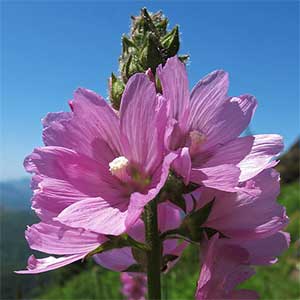Sidalcea hirtipes
Sidalcea ranunculacea
bluff mallow, bristly-stem checker-mallow, bristly-stem checkerbloom, hairy-stem checkermallow
Big Tree checkerbloom, marsh checker mallow, marsh checkerbloom
several, scattered, erect, arising from rhizome apices, usually slightly hollow, densely, harshly bristly-hirsute, hairs stiff, pustular, simple, forked, or stellate, often 2–2.5 mm.
usually scattered, ascending to erect, solid, sometimes glaucous, proximally usually long bristly-hirsute, hairs simple or few stellate, rarely glabrous, distally stellate-hairy.
basal and cauline;
stipules linear-subulate, 6–8 × 1–1.5 mm;
petioles of proximal leaves 20–30 cm, 3 times as long as blades, reduced distally to 1/2 times as long as blades;
blades: basal and proximalmost orbiculate to reniform, shallowly 5–9-lobed, 10–15 × 10–15 cm, thick, base narrowly cordate, lobe margins coarsely crenate-dentate, apex rounded, surfaces coarsely hirsute, hairs stiff;
distal orbiculate, deeply palmately 5–7-lobed, incised ± to base, lobes sometimes lobed again, base cuneate, apex acute, deeply 2–3-toothed, surfaces long-hirsute or with 2–4-rayed, stellate hairs abaxially.
mostly cauline (on reproductive stems), basal present mostly when stems young;
stipules lanceolate to ovate, (3–)4–5 × 0.8–3 mm;
proximal petioles 7–12 cm, 3–4 times blade length, distal usually 1/2–1 times blade length;
blade often grayish green, reniform or reniform-orbiculate, 2.5–6 × 2.5–6 cm, base wide-cordate, margins ciliate, apex rounded overall (lobes can be acute), surfaces softly stellate-hairy to silky villous-hirsute;
basal shallowly, palmately 5-lobed, lobe not 1-sided, 3–8 cm, elongating in fruit;
bracts linear, unlobed or infrequently 2-fid, 2–5 mm, subequal to or longer than pedicels, much shorter than calyx.
erect, spiciform to subcapitate, dense, calyces usually conspicuously overlapping in flower and sometimes in fruit, proximals usually long-pedunculate, unbranched or branched, 20+-flowered, 10+ flowers usually open on spike at same time, not interrupted, not 1-sided, usually to 8 cm, usually not elongate but sometimes slightly elongated in some populations and to 20 cm in fruit;
bracts paired or single, linear, distal undivided, proximal distinct to base, 6 mm, mostly slightly longer than pedicels.
1–3(–5) mm;
involucellar bractlets absent.
1–3(–5) mm;
involucellar bractlets absent.
bisexual or unisexual and pistillate, plants gynodioecious;
calyx often purple tinted, 9–11 mm, to 11–16 mm in fruit, margins ciliate, hairs 1–2 mm, surfaces finely stellate-hairy at base and with coarser, longer, simple and stellate hairs apically;
petals usually pale pink to rose-lavender, rarely white, slightly or not pale-veined, (9–)10–21 mm, pistillate often 9–14 mm;
staminal column 5–7(–10) mm, hairy;
anthers white;
stigmas 5–10.
bisexual or unisexual and pistillate, plants gynodioecious;
calyx 5–9 mm, stellate-puberulent and softly long-hirsute with marginal bristles 1.5 mm;
petals magenta-pink, drying dark purple, sometimes pale-veined, 5–15 mm, pistillate darker, 5 mm;
staminal column 3–6 mm, hairy;
anthers white;
stigmas 6–8.
2.5–3.5 mm.
1.5–2 mm.
7–8 mm diam.;
mericarps 5–10, 3.5–4 mm, glabrous or sparsely stellate-puberulent, roughened, prominently reticulate-veined, sides rugose and pitted, back less so, mucro 0.6–0.8 mm.
4–5 mm diam.;
mericarps 6–8, 2.5 mm, glabrous or sparsely stellate-puberulent, sides slightly reticulate-veined, back rougher, pitted, mucro 0.5 mm.
= 60.
= 20.
Sidalcea hirtipes
Sidalcea ranunculacea
Of conservation concern.
Sidalcea hirtipes is uncommon and known from Clatsop, Lincoln, and Tillamook counties in Oregon and Clark, Lewis, and Wahkiakum counties in Washington. Its elevation and habitat vary, and it seems as much at home on steep coastal cliffs as in more inland, historic prairies and mountain meadows. Populations can appear to be large because of the long-rhizomatous and clonal nature of the plants; they are few and local. It is threatened by grazing, loss of habitat, fire suppression, road construction and maintenance, and changes in hydrology. It is a candidate for listing in Oregon and has been listed as endangered in Washington. Sidalcea hirtipes is characterized by its coarse indument of bristle hairs, its generally compact spikelike inflorescences, its relatively few, large, erect, hirsute leaves, and, especially, its extensive, coarse rhizomes. The inflorescences in some populations are elongated in fruit; its range, hirsute indument, and thick leaves along with coarse rhizomes help to distinguish it from other species. Stem internode length varies depending on habitat, as in many other Sidalcea. Molecular data suggest a relationship among S. hirtipes and S. asprella, S. celata, and S. gigantea (K. Andreasen and B. G. Baldwin 2003).
(Discussion copyrighted by Flora of North America; reprinted with permission.)
Sidalcea ranunculacea is uncommon and generally found in the vicinity of Sequoiadendron, hence the common name, in the Greenhorn Mountains of Kern and Tulare counties. The interrupted inflorescences, with as much as 5–15 cm of exposed rachis between flower clusters in well-developed individuals, are distinctive, as are the slender rhizomes and relatively small flowers. In some respects it resembles S. reptans, which is more widely ranging in similar habitats and also has long bristles at the base of its stems and slender rhizomes.
(Discussion copyrighted by Flora of North America; reprinted with permission.)


